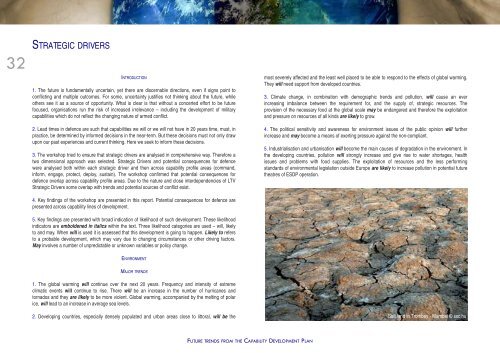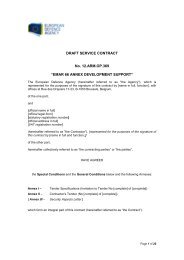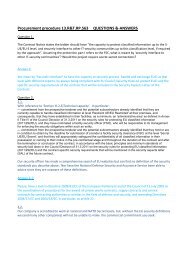capability development plan - European Defence Agency - Europa
capability development plan - European Defence Agency - Europa
capability development plan - European Defence Agency - Europa
You also want an ePaper? Increase the reach of your titles
YUMPU automatically turns print PDFs into web optimized ePapers that Google loves.
32<br />
STRATEGIC DRIVERS<br />
INTRODUCTION<br />
1. The future is fundamentally uncertain, yet there are discernable directions, even if signs point to<br />
conflicting and multiple outcomes. For some, uncertainty justifies not thinking about the future, while<br />
others see it as a source of opportunity. What is clear is that without a concerted effort to be future<br />
focused, organisations run the risk of increased irrelevance – including the <strong>development</strong> of military<br />
capabilities which do not reflect the changing nature of armed conflict.<br />
2. Lead times in defence are such that capabilities we will or we will not have in 20 years time, must, in<br />
practice, be determined by informed decisions in the near-term. But these decisions must not only draw<br />
upon our past experiences and current thinking. Here we seek to inform these decisions.<br />
3. The workshop tried to ensure that strategic drivers are analysed in comprehensive way. Therefore a<br />
two dimensional approach was selected. Strategic Drivers and potential consequences for defence<br />
were analysed both within each strategic driver and then across <strong>capability</strong> profile areas (command,<br />
inform, engage, protect, deploy, sustain). The workshop confirmed that potential consequences for<br />
defence overlap across <strong>capability</strong> profile areas. Due to the nature and close interdependencies of LTV<br />
Strategic Drivers some overlap with trends and potential sources of conflict exist.<br />
4. Key findings of the workshop are presented in this report. Potential consequences for defence are<br />
presented across <strong>capability</strong> lines of <strong>development</strong>.<br />
5. Key findings are presented with broad indication of likelihood of such <strong>development</strong>. These likelihood<br />
indicators are emboldened in italics within the text. Three likelihood categories are used – will, likely<br />
to and may. When will is used it is assessed that this <strong>development</strong> is going to happen. Likely to refers<br />
to a probable <strong>development</strong>, which may vary due to changing circumstances or other driving factors.<br />
May involves a number of unpredictable or unknown variables or policy change.<br />
most severely affected and the least well placed to be able to respond to the effects of global warming.<br />
They will need support from developed countries.<br />
3. Climate change, in combination with demographic trends and pollution, will cause an ever<br />
increasing imbalance between the requirement for, and the supply of, strategic resources. The<br />
provision of the necessary food at the global scale may be endangered and therefore the exploitation<br />
and pressure on resources of all kinds are likely to grow.<br />
4. The political sensitivity and awareness for environment issues of the public opinion will further<br />
increase and may become a means of exerting pressure against the non-compliant.<br />
5. Industrialisation and urbanisation will become the main causes of degradation in the environment. In<br />
the developing countries, pollution will strongly increase and give rise to water shortages, health<br />
issues and problems with food supplies. The exploitation of resources and the less performing<br />
standards of environmental legislation outside Europe are likely to increase pollution in potential future<br />
theatres of ESDP operation.<br />
ENVIRONMENT<br />
MAJOR TRENDS<br />
1. The global warming will continue over the next 20 years. Frequency and intensity of extreme<br />
climatic events will continue to rise. There will be an increase in the number of hurricanes and<br />
tornados and they are likely to be more violent. Global warming, accompanied by the melting of polar<br />
ice, will lead to an increase in average sea levels.<br />
2. Developing countries, especially densely populated and urban areas close to littoral, will be the<br />
Salt land in Trombay - Mumbai © sxc.hu<br />
FUTURE TRENDS FROM THE CAPABILITY DEVELOPMENT PLAN

















